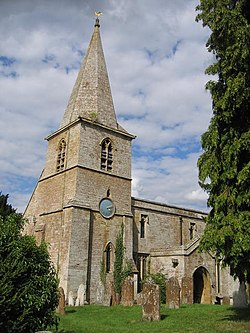Swerford
| Swerford | |
| Oxfordshire | |
|---|---|
 St Mary, Swerford | |
| Location | |
| Grid reference: | SP373311 |
| Location: | 51°58’38"N, 1°27’28"W |
| Data | |
| Population: | 132 (2011) |
| Post town: | Chipping Norton |
| Postcode: | OX7 |
| Dialling code: | 01608 |
| Local Government | |
| Council: | West Oxfordshire |
| Parliamentary constituency: |
Witney |
Swerford is a village on the River Swere in the Cotswold Hills of Oxfordshire, about four miles north-east of Chipping Norton. Swerford has two main neighbourhoods: Church End and East End: the area between them containing very few houses and is called Between Towns.
The 2011 census recorded the parish's population as 132.
Contents
Churches
The parish church, St Mary, is believed to have been founded by Osney Abbey early in the 13th century. The earliest part of St Mary's present building is the tower and spire, which were built around 1300. The Decorated Gothic nave may have been built between 1250 and 1350. Perpendicular Gothic additions were made early in the 15th century: the chancel, and the clerestory of the nave. In 1846 the Gothic Revival architect H.J. Underwood added the north aisle.[1] St. Mary's is now part of the Benefice of Hook Norton with Great Rollright, Swerford and Wigginton.
The vicarage was built in the 18th century.[2]
A Methodist chapel was opened in Swerford in 1938. It was closed in 1992 and is now a private house.[3]
History
The Domesday Book records that in 1086 Swerford was part of the royal manor of Hook Norton, which was held by Robert D'Oyly. The village has a motte-and-bailey castle which is believed to have been built early in the 12th century during the civil war between Empress Matilda and King Stephen.[4] In 1783 Henry Scott, 3rd Duke of Buccleuch commissioned the building of the country house of Swerford Park as a hunting lodge.[5] In 1820 General Sir R. Bolton bought the house. Bolton commissioned the artist and architect Joseph Gandy, who remodelled the house between 1824 and 1829 in the style of Sir John Soane.[2]
Old Clock Cottage was built in the 18th century.[2] By 1881 a railway tunnel 418 yards long[6] had been built through South Hill just west of Swerford Park for the Banbury and Cheltenham Direct Railway. The railway company usually called it Hook Norton Tunnel but sometimes it is called Swerford Park Tunnel. The line's nearest railway station to Swerford was about a mile and a half away at Hook Norton. British Railways closed Hook Norton station in 1951 and closed the Banbury and Cheltenham railway completely in 1964. The tunnel is now bricked up at both ends to prevent access, both for people's safety and to protect any bats that may roost inside.
Outside links
| ("Wikimedia Commons" has material about Swerford) |
References
- ↑ Sherwood & Pevsner 1974, p. 798.
- ↑ 2.0 2.1 2.2 Sherwood & Pevsner 1974, p. 799.
- ↑ "Swerford Chapel". West Oxfordshire Community Web. http://www.wospweb.com/site/Swerford/Swerford-Chapel.htm.
- ↑ "The Early History of Swerford". West Oxfordshire Community Web. http://www.wospweb.com/site/Swerford/Swerford-Castle.htm.
- ↑ "Swerford Park". Parks & Gardens UK. http://www.parksandgardens.org/places-and-people/site/3199.
- ↑ "page 2". Railway Tunnel Lengths. David Eaves. http://www.railwaycodes.org.uk/tunnels/tunnels2.shtm#HookNorton.
- Nikolaus Pevsner: The Buildings of England: Oxfordshire, 1974 Penguin Books ISBN 978-0-300-09639-2
